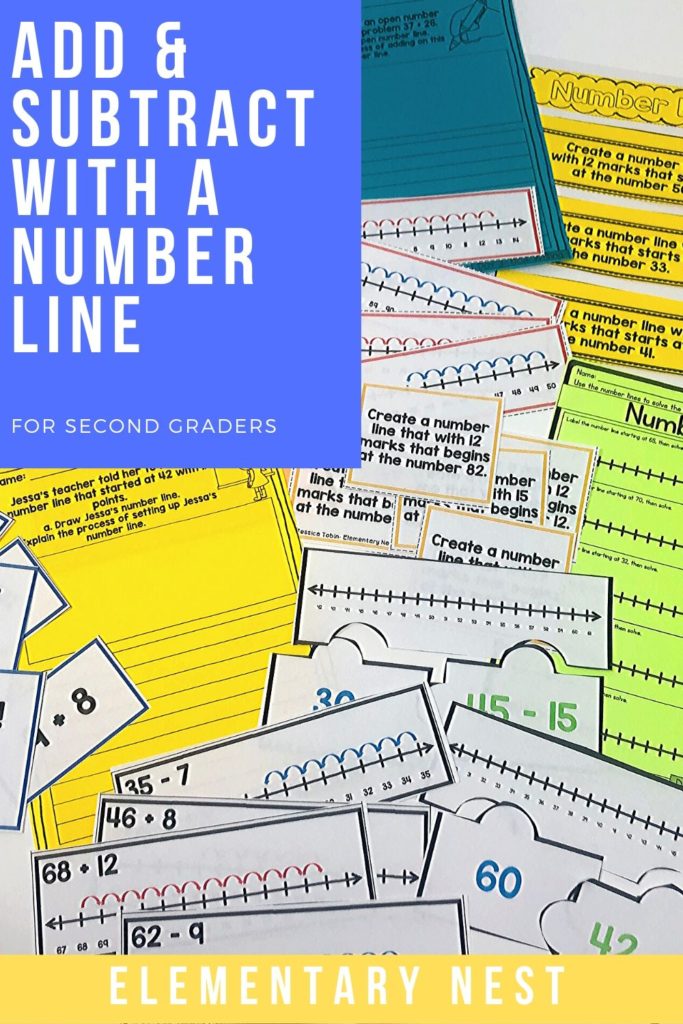

In this blog post, you will find a variety of number line strategies to help students learn how to use a number line to represent whole numbers as lengths and solve addition and subtraction problems. In 2nd grade, students will begin representing whole number sums and differences within 100 on a number line. First, it is important to introduce the concept of a number line so that students can study it’s attributes and uses. Next, build on this knowledge by having students create and label number lines. Finally, your students will be ready to apply these number line strategies to solve addition and subtraction problems.
2nd Grade MD 6. Represent whole numbers as lengths from 0 on a number line diagram with equally spaced points corresponding to the numbers 0, 1, 2, …, and represent whole-number sums and differences within 100 on a number line diagram.

When introducing number lines to your students, it is helpful to begin with visual anchor charts. These anchor charts explain what a number line is, the variations of number lines, and how to use them to represent numbers and solve addition and subtraction problems. This allows the students to see exactly how whole numbers are represented as equally spaced lengths on a number line. The color-coded characteristic also makes it easier for the students to differentiate showing addition and subtraction on the number line. I like to post these anchor charts on my math wall after discussing so the students
can reference them throughout the unit. Consequently, this gives the students the confidence to know where to look if they need a reminder, thus making them more independent.

Before students begin applying number line strategies to addition and subtraction problems, it is essential that they learn how to create and label number lines. Since this 2nd grade standard has students working with numbers within 100, they must be able to represent and label these numbers on a blank number line first. Start by having them create and label a number line that begins at 0 and ends at a given number, such as 10 or 20. Discuss how many marks they will make to show the whole number. Then, challenge them to start at a given number, instead of 0. When working on this skill, I like to use these task cards to practice. Encourage students to keep their marks evenly spaced as they create their number lines. A ruler may be helpful.

Once your students are creating and labeling number lines with precision and mastery, it is time to introduce addition and subtraction number line strategies. This would be a good time to reference the anchor chart from above again. Begin by demonstrating simple addition problems on a closed number line beginning at 0 and ending at 10 or 20. Model how to make jumps forward to solve addition problems. Students will learn to start on the first number and jump forward the number of spaces they are adding. I like to have my students circle the sum that they landed on.
In the same manner, model how to jump backwards to solve subtraction problems. Using their prior knowledge, the students will understand that they will start on the largest number and jump backward the number of spaces they are subtracting. Again, have them circle the difference that they landed on. After practicing and modeling this, you may begin to have the students work with number lines that begin and end at any given number within 100. During this time, I like to have my students use red to show addition jumps and blue to show subtraction jumps. This solidifies the visual on the anchor chart.
After ample practice, this is the perfect time in the lesson to introduce the concept of open number line strategies. When working with open number lines, students must understand the importance of labeling the marks at the bottom of the number line. To add, use the easier number to draw on the number line and then jump forward to solve. To subtract, draw the larger number on the number line first and then jump backwards to solve. As always, repetition is key with this skill!

When teaching number line strategies, practice makes perfect! Ultimately, we want to give our students many different opportunities and activities to work with these number line skills:
From whole group visual instruction to hands-on partner or small group work, such as this puzzle activity above, to independent practice, students will be applying these number line strategies in a variety of ways. Continuously building on what they have learned will help them develop a strong understanding of the concept.

A key element of mathematics instruction is writing about math. This process allows you as the teacher to assess a students’ knowledge of the number line strategies. It also gives them an opportunity to walk through the process step-by-step. Connecting the hands-on number line activities to writing is a powerful process for students.

This unit breaks down this 2nd grade standard, teaching students how to create and label a number line to represent whole numbers and solve addition and subtraction problems within 100. All of the images you see throughout this blog post come from the 2.MD.6 unit on number lines and open number lines.
Want to read more math blog posts?